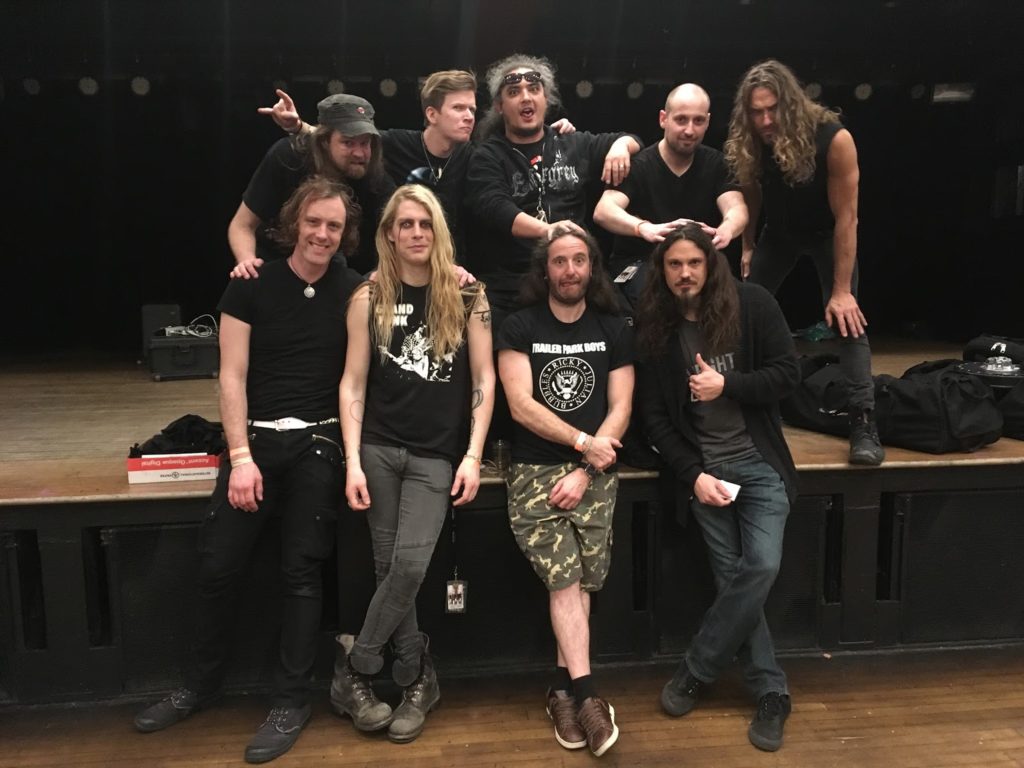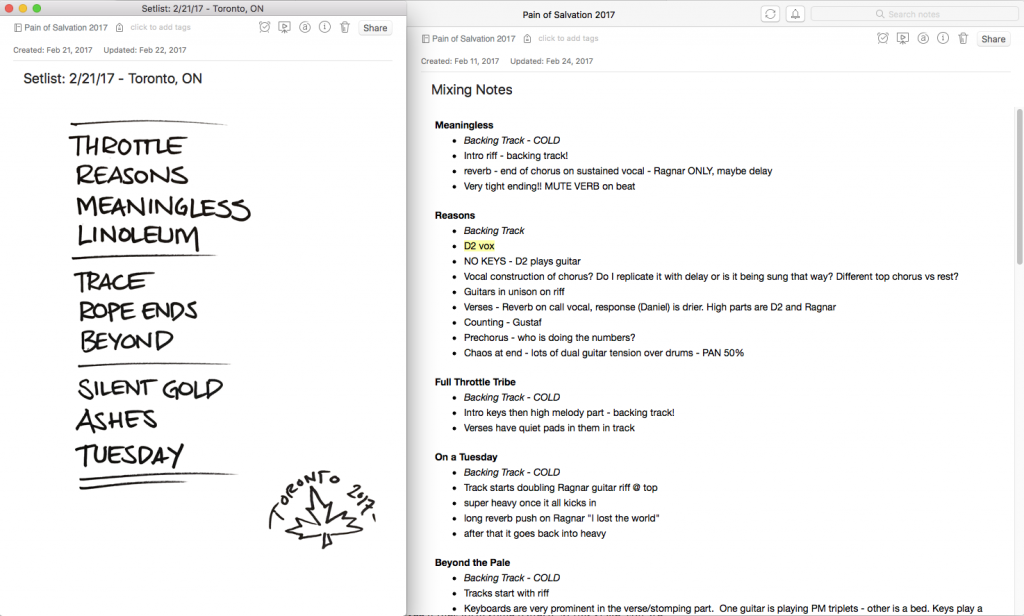Rock & Roll tours with Qlab (and help from Evernote)
TL;DR:
Qlab is not just a tool for theatre. And it isn’t just for playing back media cues!
The Story:
I have been the North American sound engineer for Pain of Salvation (https://painofsalvation.com) for a few tours. I could go on at length how awesome that job is. One of of the issues we deal with is the fact that the band flies in from Sweden, and there are real budget constraints we have to respect to keep the accountants happy. That means we are limited in the amount of gear we can carry around.
As a result, we rely on the house PA system. I program the show for the sound boards that I will be mixing on using their offline editors. The last tour saw me with 5 or 6 different versions of the show – one for a Yamaha, ones for the Midas M32 and Pro2, Avid…it goes on. And those files were constantly getting edited on the bus as the tour rolled on, as we made changes from night to night. And then there would be the analog boards, where I had to work off my printed notes… All in all, the basic sound engineer stuff. Lots of spreadsheets. The only PA gear we brought was a stage box to feed the in-ears, which had to be patched and split every night. So mixing the show meant prep for the board, and then reading the notes I had made for each song – no scene changes, automations, or other amenities offered by digital consoles.
My point is that, while I was doing the normal work of a sound engineer and production manager, it was still a lot of work, as any touring guy will tell you. We work hard, earn the money, and love the job – and I get to hang out with my friends for a few weeks:

But what if I could make it easier? There is no budget for an assistant, never mind any room on the bus. What if I could automate the little things I did, so that I could do my main job BETTER? Automation of computer tasks is not leading to a world where we get more time on the beach – it’s allowing us to focus on the tasks that matter most. For me, that meant firing up Qlab.
Through this tutorial, I will also show how I used Evernote, an amazing application my wife hooked me onto, as well as Logic, which I was using to record every show – all in one workflow.
The Esoteric Bit:
First off, I needed a kicking playlist, to get the crowd pumped up as our direct supporting act, District 97 (http://district97.net), moved off the stage. That music lived in a secondary Cue List, and was triggered by a play cue, keeping it out of the way and out of sight.
I used this script, featured in an earlier blog post, to figure out how long the music would play and if I needed to add more songs:
https://www.rocktzar.com/long-qlab-playlist/
At soundcheck, I opened Qlab, which could trigger my noise generator, as well as have my reference music ready to play after I tuned the room. I also ran my script to set the laptop volume level, in case I listened to headphones on the bus. At the end of the soundcheck, you’ll see I have a trigger to open the applications I would be using during the show – namely, Logic and Evernote (and bundled in a “Quit ToneGenerator” command for good measure).

Showtime.
While our direct support District 97 moved off stage, and the house engineer cleaned up the booth. I hit GO to start the house music on my laptop, and headed through the crowd. I had taken on the role of guitar tech for the tour as well, so the house guy would load my show that was saved at soundcheck as I started bringing out pedals and guitars to the stage, getting things placed and tuned.
The band would be in the dressing room with final prep, listening to my mic checks on their in-ears. They were also working on the setlist, which would be written out in sharpie on paper.
Here is where the whole “automation saves time” comes into play. I’d take a photo of the setlist using Evernote, which, in addition to saving it for posterity, meant it was getting synced over the Internet to my laptop running Evernote. (I could also share this note with the agent back home, who is a fan.) By the time I got back to the board, the setlist was there as an image.
My next GO cue in QLab would run a number of things:

- Send a command to Logic to start recording (I had a USB mic on a stand next to the booth.)
- Give focus to Evernote, which resulted in displaying my virtual sharpie on paper, alongside my mixing notes for the songs.
- Fade out the house music and pause.
- Had I thought about it at the time, I would have also started a timer, so that, combined with a timer at the end of the show when house music resumed, would have told me how long the show ran without looking at a watch and marking the time.
Bam. Instead of rushing through the crowd to get myself situated and remember to hit record, etc, I could arrive at the board clear-minded and ready to mix, and hit that go button. I’d have this view on my laptop screen:

The one other thing the band and I talked about adding to this cue was triggering the band’s walk on/backing track. But we came up with it on the bus mid-tour, and it was a little too late to sort out the networking involved, even though we had a wireless access point for our stage monitors. The tracks were coming from D2’s keyboard rig, which was running Mainstage. So had we the time, we probably could have made it work, by sending a MIDI or OSC command to his laptop.
Instead, someone had to sneak on stage to hit the button.
At the end of the show, I’d Command+Tab over to Qlab and hit go one more time to start up the music, stop the recording in Logic, and quit Evernote. (I don’t remember why I left the note to myself that I was not saving or quitting Logic with that cue…)
So there you have it. Using a different house system every night is a lot of work. You might not have to load in as much gear, but there is a lot to figure out and set up. While I did use QLab to play back audio cues (house music), most of the work was simply automating my tasks, and providing me a platform to organize those tasks within an environment I would probably need to use anyway (because iTunes just won’t cut it).
Cheers!
-brian
PS – Thanks again to Mic Pool on the Qlab forums (https://groups.google.com/forum/#!forum/qlab) – I wanted to clean up something in my programming, which had been done on the fly on tour, before posting here. I then created an issue with a fade in, and he was able to find my error. He also wrote the script I referenced at the beginning of this post, regarding calculating the length of a set of tracks. Amazing designer. Thanks, Mic!